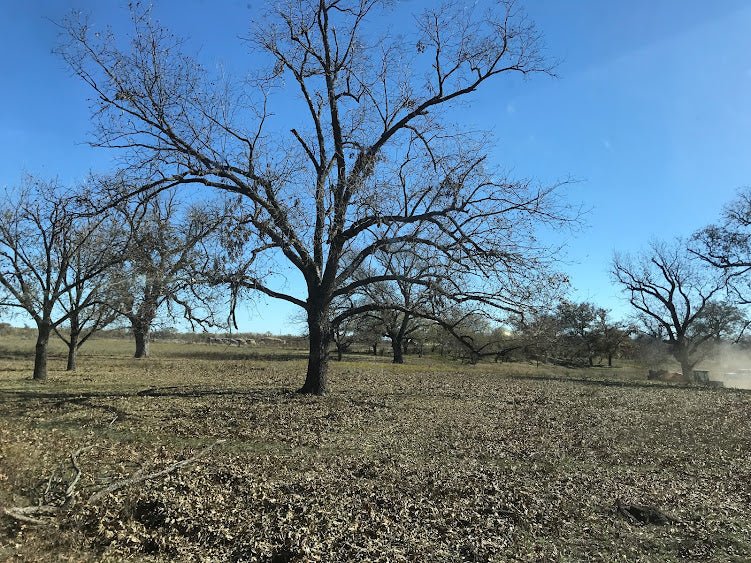
John R. Cole, Pathologist Crops Research Division Agriculture Research Service U. S. Department of Agriculture
Scab is by far the most important of the many fungus diseases of the pecan. Others such as downy spot, vein spot, brown leaf spot, liver spot, and leaf blotch, which affect the foliage, may cause partial loss of the pecan crop in some localities in some years. However, under conditions favorable for its development such as rainy humid weather, scab can and does cause partial to total loss of the pecan crop on certain varieties annually. Scab is one of the most limiting factors in pecan production in localities where high susceptible varieties are grown and where high humidity prevails.
DEVELOPMENT AND CONTROL OF PECAN SCAB
Overwintering of scab fungus:
The scab fungus is carried over winter on old leaves, shucks, and twigs of the trees. When the weather (showery, humid atmospheric conditions) becomes favorable in the spring any time after the buds begin opening, the fungus becomes active and produces spores. These spores are carried to the new leaves and shoots by rain, wind, and possibly to some extent by insects and eventually reach the nuts. On varieties highly susceptible to scab, many pecan growers have no doubt observed these early scabs lesions surrounding a previous season's shuck or mummy nut that remained over winter on the tree. It is absolutely necessary that old shucks, mummies, and leaf stems be removed before foliation of trees in the spring if a serious epidemic of scab is to be avoided.
Relation of rainfall and its distribution to scab development and control:
Primarily infection of leaves, shoots, and nuts by the scab fungus occurs during cloudy or rainy periods in spring and early summer when the plant parts remain wet overnight, or for about 12 hours. Under such conditions the primarily infections may develop rapidly, sometimes as early as the middle of April in the Southeastern States. Under ideal conditions spores can germinate and cause infection within about 6 hours. During damp periods new crops of spores that cause secondary infections are produced during the latter part of April or the first part of May.
The writer has experienced difficulty in controlling pecan scab when the rainfall was frequent and excessive during the growing season from April to October. At Fort Valley, Georgia, in 1957, for example, when the annual rainfall was unevenly distributed, poor control of the disease on the Schley variety resulted from the use of the recommended spray program of bordeaux mixture, zineb, or ziram. In that year 38.07 inches of rain occurred between April 1 and September 30. Furthermore, many rains came during late afternoon and evening so that the leaves and nuts remained wet overnight and into the next day, thereby providing ideal periods for scab infection.
Relation of varieties to scab development:
In Texas pecan varieties vary widely in susceptibility, partly because of the wide differences in rainfall in different sections. So far as is known, all commercial varieties of western origin are susceptible to scab when grown in the more humid areas of the state, but varieties of eastern origin susceptible to scab in the Southeastern States and south and east Texas have not been attacked by scab in areas where summer and fall weather is semi-arid. Such areas usually have less than 35 inches of rainfall annually. In these areas many varieties of western origin are infected by the scab fungus, particularly in the lowlands and where air drainage in the orchard is poor.
On varieties highly susceptible to scab, such as Halbert, Sovereign, Squirrel, and Burkett, the primary infections occur early on the foliage. Secondary infections, which eventually cause defoliation, may occur later. On varieties more resistant to scab, many of which are grown in Texas, primary infections may take place late in the season when the leaves are resistant; therefore, infections are confined largely to the nuts. The nuts of highly susceptible varieties may be so extensively infected that practically the entire surface appears black and most of them drop prematurely. Under other circumstances the nuts may remain on the trees as mummies until the following spring.
Control of pecan scab:
The climatic conditions in Texas vary so widely that it is impossible to make a blanket or general recommendation for scab control by spray applications of fungicides. In the southern part of the state, more specifically near Houston, eastern varieties predominate; since the annual rainfall compares with that of Georgia, a full scab-control program is recommended for the more susceptible varieties. This includes two pre-pollination applications of bordeaux mixture, ziram, or zineb and four cover-spray applications-of the same fungicides. In many areas of the state where the annual rainfall is less than 35 inches a modified spray schedule may be used. This is especially true when early infections do not occur on the foliage. Two or three cover-spray applications of bordeaux mixture, ziram or zineb will usually control scab on the nuts in these semi-arid areas. In some sections of east Texas, and for the less susceptible varieties in south Texas, one pre-pollination spray application of bordeaux mixture, ziram, or zineb when the first leaves are half grown, followed by three cover applications of the same fungicides will control scab. In case a grower has only a few trees of susceptible varieties scattered throughout his orchard it may be advisable to topwork them to scab-resistant varieties rather than to spray them for control of scab.
Some growers have preferred to topwork large numbers of trees of susceptible varieties to more resistant varieties rather than to spray for control of scab. However, there is a risk that a resistant variety may in the future become susceptible to scab. Therefore, if a pecan grower decides to topwork scabbing varieties the writer recommends that several resistant varieties be used and spaced at least in alternate rows in order to avoid large blocks of trees on the same variety. The history of the pecan industry shows that topworking or planting large blocks of trees can be detrimental when the designated strain of the scab fungus from the slightly susceptible or resistant variety becomes established in the block of trees. A good example can be found near Monticello, Florida, where a large acreage of Schley trees was topworked to the then only slightly susceptible Moore variety. The Moore trees are now scabbing more severely than the few Schley trees that were left.
The Stuart variety, which remained resistant to scab for many years, is now susceptible in some locations in Mississippi and Louisiana and can no longer be considered a scab-resistant variety in those areas. Therefore, growers should use the most scab-resistant varieties available with a record of high production of good-quality nuts if present scabbing varieties are to be topworked.
DEVELOPMENT AND CONTROL OF PECAN FOLIAGE DISEASES
The most prevalent of the foliage diseases of pecan in Texas are downy spot, vein spot, and liver spot. Brown leaf spot occurs in some orchards in southeast Texas. The fungi causing foliage diseases are carried over winter on the leaves. Under favorable conditions sporulation of the downy spot and vein spot fungi occurs early in the spring along with the early sporulation of scab. Sporulation of liver spot and brown leaf spot fungi occurs somewhat later in the spring.
In general, a complete scab spray program will control the above mentioned diseases, but in rainy seasons it may be difficult to control vein spot and downy spot with spraying alone. Thorough covering of old leaves by plowing in early spring before growth starts will aid in controlling foliage diseases, especially vein spot and downy spot. One application of 6-2-100 bordeaux mixture or 2-100 ziram or zineb about May 15 will control liver spot and brown leaf spot and generally will prevent late infections by the downy spot fungus.
Information on formulations and timing of spray applications for control of foliage diseases and pecan scab as well as for insect control is contained in Farmers' Bulletin No. 1829, published by the U. S. Department of Agriculture; this bulletin is available at county agricultural agents' offices. In addition, many state agricultural extension services publish spray schedules adapted to the particular conditions in their states.
PROBLEMS IN CONTROL OF PECAN SCAB AND FOLIAGE DISEASES
Many growers have other interests that conflict with care of pecan trees, especially spraying to control diseases and insects. In some cases the main crop on a farm, such as cotton, is considered to be the major, or high-income, crop, and naturally its care takes precedence over that of the pecan, which is considered a low-income crop. The writer is of the opinion that with average pecan yields the grower must get at least 25 cents per pound for the nuts to afford to carry out a complete spray schedule for disease and insect control in humid areas. Furthermore, where growers pasture cattle in their orchards, as is often the case, there is some danger to the cattle from the use of fungicides and insecticides. The grower must make many decisions of an economic nature, and spraying to control scab, foliage diseases, and insects is just one of them. Fortunately, most fungicides and insecticides are compatible and therefore separate applications are not needed for the various pests.
Low-lime bordeaux mixture has been the standard fungicide recommended for the control of scab and foliage diseases for a number of years. But this material has its disadvantages. Under some conditions, especially during long periods of drought, it may injure both foliage and nuts. In addition, its use has a tendency to increase black aphid and mite infestations. For this reason another fungicide such as ziram or zineb plus summer oil emulsion is recommended in all areas where pecans are grown. Alternating bordeaux mixture with these fungicides has also proved successful where a full spray schedule is required to control scab or foliage diseases.
CONCLUSIONS
Pecan scab is the most important and widespread of the pecan diseases. Many varieties once considered immune from the disease have later become very susceptible. Therefore, there is no assurance that presently resistant varieties may not eventually be attacked by the fungus. The disease can be controlled economically in most instances by proper application of fungicides provided the variety sprayed is capable of producing good crops of high-quality nuts. Extreme care should be exercised in selection of new scab-resistant varieties for topworking of presently susceptible varieties so as to insure good production of good quality nuts. Also, it is not desirable to topwork large blocks of trees to a single currently-resistant variety since scab is more likely to develop under such conditions than where several varieties are scattered in the orchard.
Most of the foliage diseases are controlled by applications of fungicides. In severe cases of vein spot or downy spot, it may be necessary to supplement spraying with orchard sanitation.
Above all, pecan trees should be kept in a vigorous condition by proper orchard-management practices so that they are able to produce good crops of nuts when diseases and insects are controlled.

